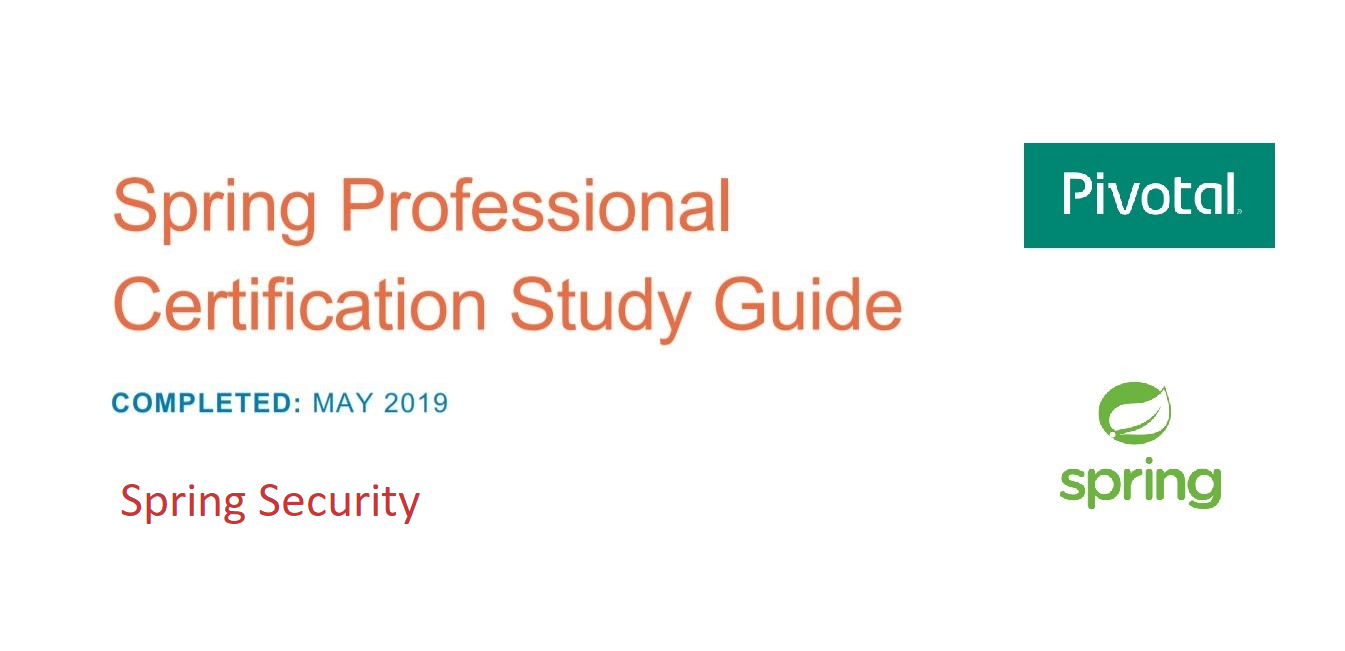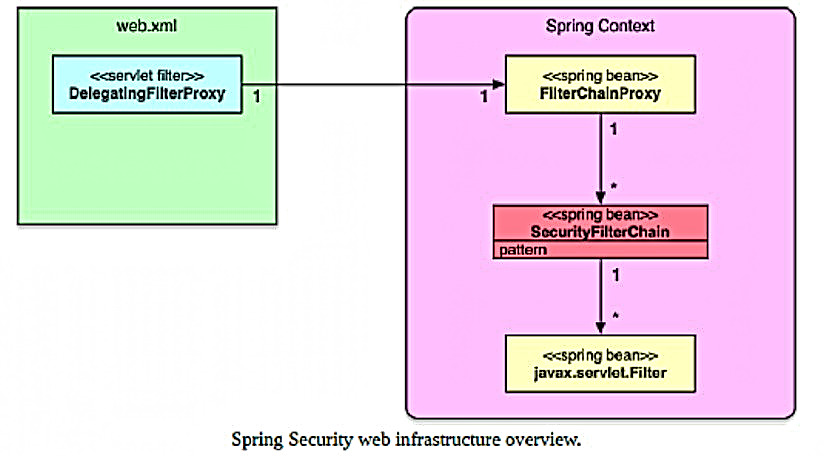Preparing for Spring Professional Certification. Spring security
This article is a translation of the Spring Professional Certification Prep article.
It will cover the topic of Spring Security and its main questions.
It can also be used to prepare for an interview.
↓ Other articles are available at the links in the table of contents ↓
- Dependency injection, container, IoC, beans
- AOP (aspect-oriented programming)
- JDBC, Transactions, JPA, Spring Data
- Spring boot
- Spring mvc
- Spring security
- REST
- Testing

Questions themselves:
Authentication is the process of verifying the user of a computer system.
This is how it happens in Spring:
- The resulting password and username is converted to an instance of UsernamePasswordAuthenticationToken . It implements the Authentication interface.
- The token is passed to the
AuthenticationManager
object for verification - If successful, AM returns a populated
Authentication
object - The security context is set by calling
SecurityContextHolder.getContext().setAuthentication(...)
Authorization is the process of verifying that the user has the role required to take an action. During authorization, it is checked whether you have the appropriate rights to access the resource.
Process:
- By the principal (principal) of the user, his role is displayed
- User role checked against resource role
First, authentication takes place, and then authentication.
Using Spring AOP proxies that inherit from the AbstractSecurityInterceptor class.
It is used for methods that call authorization.
Security web infrastructure is based on servlet filters.
The first step is to configure the DelegatingFilterProxy
filter. He delegates the request to FilterChainProxy
.
FilterChainProxy
is a bean that accepts one or more SecurityFilterChain
in the constructor.
SeccurityFilterChain
compares the URL in the request with a list of filters.

SecurityContextHolder
- contains and provides access to the SecurityContext in the application.
SecurityContext
- the default implementation of Spring Security containing the Authentication object.
Authentication
- provides a token for an authentication request or for a principal who has authenticated. It also contains a list of powers that the principal has access to.
GrantedAuthority
- Contains the authority granted to the GrantedAuthority
principal.
UserDetails
- contains information about the user: password, login, permissions. This information is used to create an Authentication object after successful authentication.
UserDetailsService
- this service extracts information about the user from the repository (program memory, database, etc.) and puts it in UserDetails.
The DelegatingFilterProxy
class is a class that implements the javax.Servlet.Filter
interface.
This is a special filter that delegates the work to other beans, which are also filters.
The filter chain implements the SecurityFilterChain
interface. The implementation provided by Spring Security is DefaultSecurityFilterChain.
The DSFC constructor accepts several parameters. The first parameter is request matcher. The remaining parameters are filters that implement the servlet.Filter interface. Here are all the filters accepted by DSFC:
-
ChannelProcessingFilter
-
SecurityContextPersistenceFilter
-
ConcurrentSessionFilter
- Any auth. filter:
UserNamePasswordAuthenticationFilter
/CasAythenticationFilter
/BasicAuthenticationFilter
-
SecurityContextHolderAwareRequestFilter
-
JaasApiIntegrationFilter
-
RemeberMeAuthenticationFilter
-
AnonymusAuthenticationFilter
-
ExceptionTranslationFilter
-
FilterSecurityInterceptor
The primary object is a SecurityContextHolder
. This is the place where details about the current security context are stored, for example, details of the principal who is currently using the application. By default, ThreadLocal
used for storage.
// SecurityContext SecurityHolderContext.getContext()
The object returned by the getContext()
method is SecurityContext
. It allows you to receive and set up an Authentication
object.
Authentication
represents the following properties:
- The collection of powers granted to the principal
- Data for user identification (login, password)
- Details - add. information, if needed. May be null
- Principal
- Authentication flag - boolean variable that indicates whether the principal passed the test successfully
@Override protected void configure(HttpSecurity http) throws Exception { http.authorizeRequests() // /resources .antMatchers("/resources/**").permitAll() // 2 .antMatchers("/").hasAnyRole("ANONYMOUS", "USER") .antMatchers("/login)*").hasAnyRole("ANONYMOUS", "USER") .antMatchers("/logoutr").hasAnyRole("ANONYMOUS", "USER") // ADMIN .antMatchers("iadmin/*").hasRole("ADMIN") .antMatchers("/events/").hasRole("ADMIN") }
This expression means “any.”
There are 2 types:
*
- intercepts only at the level at which it is used.
For example, the pattern “/ orders / *” will check the user’s rights if the user follows
/ orders / aliens or / orders / 1, but not / orders / alien / 1.
**
- intercepts at all levels.
Any requests will be checked, / orders / aliens, / orders / 1, / orders / alien / 1.
Because antMatcher(“/service”)
maps the request path only to “/service”
, while mvcMatcher(“/service”)
maps to “/service”
, “/service.html”
, “/service.abc” .
Yes, it does. There is a PasswordEncoder
interface for hashing, which contains only one method:
static PasswordEncoder createDelegatingPasswordEncoder()
, which returns the default DelegatePasswordEncoder
.
Salt is used to calculate the password hash value. This is a sequence of random numbers that are used to convert a text password to a hash. The salt is stored in clear form next to the hash password and can be used later when converting a clean password to a hash with a new user login.
Spring Security supports the protection of individual methods in beans (for example, in controllers). This is an additional layer of protection for the application.
It must be specified explicitly using the @EnableGlobalMethodSecurity
annotation.
This annotation is based on the JSR-250.
@RolesAllowed
allows you to configure access to methods (for example, in a controller class) using roles.
Example: @RolesAllowed(“ADMIN”)
will only allow users with the ADMIN
role
To use, you need to set @EnableGlobalMethodSecurity(jsr250Enabled=true)
on the @Configuration class + you need this annotation to be in the classpath.
@PreAuthorize
allows you to configure access to the method using SpEL.
To use, you need to set @EnableGlobalMethodSecurity(prePostEnabled=true)
End-to-end functionality is used using Spring AOP (proxy objects).
All Articles